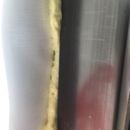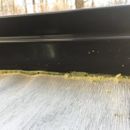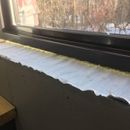Interior window sealing detail
My framers made the window rough openings a little too tight and I just can’t get the foam back inside gap. It’s just kind of making a bead in the corner. I’m using a great stuff gun. Should I trim the foam off and use some sort of caulk to seal it instead? Maybe I could use a thin shim and stuff a little fiberglass insulation in there first. Just not sure of the best solution here.
GBA Detail Library
A collection of one thousand construction details organized by climate and house part












Replies
Scott, I've heard of people inserting small flexible tubes into the installation nozzle extension that comes with canned foam, but with such a small space, the most important thing is to create a good air seal. If you can squeeze some fibrous insulation in there, go for it, but a high quality caulk or tape at the interior is more important.
Thanks Michael. I'll look into those skinny tubes, but I never thought of using tape, I guess I don't see why that wouldn't work. It may be easier and less messy than caulk. I'm using wood returns around the window and if I'm careful when taping the window frame it should get concealed by the wood returns (is that the correct term?).
Scott,
Please shake your can of foam more. That foam doesn't look too great. Also I haven't tried it myself yet, but maybe try the misting with water trick as well.
Ya it doesn't looks like you're getting it in the gap, in that case, I personally would jam some Rockwool in there as a backer, as you suggested and caulk with a good polyurethane for an airseal.
I used to use gun foam for everything, but I'm learning more of the ways of caulk for things like expansion and contraction etc.
I bet your right Jamie. I was wondering why it seemed so porus. thought maybe I had a bad batch or something. I bet I didn't shake well...or at all. Not going to be fun pulling it out of there on all my windows. Crap!
What kind of caulk would you recommend for this application?
As Michael said - use tape.
Whatever you do its going to leak air. You are sealing the window to your wrb. In your picture your wrb is wrapped back into the rough opening. When you do a blower door test air will come in behind the wrb, there is no such thing as a wrb air barrier that is effective.
Cut your wrb flush with the window frame and seal window to wrb and wrb to framing. In your situation since your rough opening is so tight I would use sealant, normally I would install a nozzle adapter to my foam gun and inject foam between the framing and wrb and second bead between the wrb and window quickly before either bead sets, that kills both pathways.
Ideally when building your wrb is cut flush with the rough opening and your window foam will seal window to framing and osb/framing joint in one shot. You will sometimes get air under your flexible pan flashing tape, especially in the corners, another spot a lot of people miss, preformed corners and sealant will take care of the pan area between framing and membrane tape. Foam between pan tape and window.
If you need to pull foam out use a recip saw blade, out of the saw, and saw the foam out by hand. It goes fast. Straw foam cans dont really put out good foam compared to gun or tank foam.
Tape isnt going to seal all the little ridges in flex wrap, it may work for awhile along the window jambs and head.
Thanks T Carlson for calling that to my attention. I hadn't considered that, but it makes perfect sense. Upon closer inspection, the Tyvek was wrapped all the way to the interior on both sides and the sloped sill. The the Flex Wrap was installed over it. The pictures above are on my workshop windows with 6" SIP walls. These pictures are on my home with 10" double stud walls. Both windows are installed/flashed basically the same way except the rough framing sill on the SIP wall isn't slopped. I am seriously disappointed on missing this detail.
You said: "Cut your wrb flush with the window frame and seal window to wrb and wrb to framing."
I highly doubt I can get sealant on both sides of the wrb. There just isn't enough room. How big a problem is this? Do I have potential water infiltration issues? I don't have the rainscreen or siding on yet...should I be considering removing and reinstalling windows or is this "just" a air sealing issue?
What do you think about this strategy: Cut the wrb back a couple inches from the window frame, lift the wrb up, apply sealant between the wrb and the framing, then seal between the wrb and the window frame?
Scott, that should work, or you can just cut the drainwrap close to the window and use a high performance tape to seal the window directly to both the framing and the WRB. It won't be perfect, as you are then making the window buck part of your airtight system, but it will work pretty well.
Side note: there are many WRBs that make great airtight layers. Drainwrap isn't one of them, though. The most popular in the US right now is Henry Blueskin VP100, but Siga and Pro Clima also have several options, including self-adhered like Blueskin.
For sealant, the best I know of for this application is Pro Clima Contega HF. The one with the longest history in the US is Tremco Acoustical Sealant. The first is super-green (and literally the color green), the second is full of nasty stuff, but both stick well and stay flexible.
Scott you can do what you are suggesting in post #9, or cut it flush with the inside frame and air cant get past the frame from either side since you are shutting off both gaps. I suggest when doing new, cutting the rough openng completely open because Ive found air leakage getting into studwall cavities from between the sheathing and framing (tiny amounts, but when going for super low air leakage it adds up) If you have wrb wrapped around that joint you are essentially giving a pathway for air leakage. Getting wrb out of the picture allows foam to block it all off assuming you have the proper rough opening. Tape wouldnt work. For a joint that small the foam does not work, I would use a nice bead of good sealant from window frame to framing on the sides and top, window frame to flex wrap along the bottom.
From an interior perspective this is an air sealing issue, sort of, your pan flashing and outboard flashing of the window will determine if it will leak behind your wrb or not.
Although your sill flashing in your last pic looks like a hot mess. It doesnt appear that your flex wrap sill flashing, or essentially your pan, is going up the side of the rough opening. If this is true, this is the number one spot on windows I see the christmas tree shape rot starting with those corners being the tip of the tree. If it does go up it looks like the tyvek somehow covers it which should not be possible. Hard to tell, but its pretty sloppy.
You dont have tyvek wrapped inside the head of the window, so thats a positive sign, I still come across that believe it or not, on new stuff.
Thanks again T Carlson. Seems like every time I feel like I have a handle on these details, I find another place I just don't. So I was thinking the same thing about how the sequence of flashing the will pan was done. I went back and found a couple pictures the refresh my memory now. The first picture I believe was right before the flex wrap was applied, and the 2nd crappy pic shows it all taped up from the outside. Curious to get some thoughts on this. I.e. Not ideal but will work vs problem waiting to happen.
Scott,
A lot depends on what happened after the windows went in. The house wrap and sill aren't wonderful, but as you say, are probably just fine.
There are at least a half-dozen different ways to install flanged windows that all work well. Martin advocates concentrating on the rough opening. I'm happy doing it similarly to this video - although for some reason they don't install head flashing.
https://www.youtube.com/watch?v=SqP4liutJFs
Always have in the mind what, at any given point, is the air barrier. If it's the sheathing, then WRB can get in the way of an air tight connection from sheathing to window.
Malcolm,
Looking at the video, there appears to be no air seal at the bottom, which is to allow for water drainage. So, where is the air seal in this scenario?
Norman,
The air-seal at the sill is at the interior face of the window frame. That's what I like about it. You keep the WRB on the exterior face of the sheathing and only the sill-pan gets wrapped, so you avoid all the which side to seal to Scott is experiencing.
As soon as you get into sloped sill pans you are left with the dilemma of how to drain them. Our code wants a clear path. At first this was done by either mounting the windows outboard of the rain-screen strips, or drilling holes in the bottom flange of the window. Now they have calmed down a bit and typically allow an unsealed bottom flange to provide the drainage plane.
To me what still seems unresolved is that on three sides you end up with insulation between the framing and the window frame, but at the sill there is nothing between the window and the sill except the air-seal (caulking or tape) at the interior. I don't know how you get around that.
Edit: Imagine how easy it is to replace the windows in this situation if you keep your rain-screen furring 1/2" back from the flanges on all sides?
Scott, I wouldnt worry about your windows.
As Malcolm said there are a lot of different ways to flash windows, yours isn't ideal to me but I dont believe its a total failure for water intrusion either. Im assuming you have exterior window tape on the jambs and then across the head and hopefully the jamb tape completely covers the lower jamb side horizontal cut in the housewrap allowing the housewrap to lap over your sill flexwrap.
That area is a weak point, there is no need to lap housewrap over the top of the upturn of the sill flex tape, that is what the jamb tape does, but at this point I wouldnt tear your windows out.